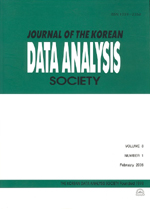Andersen 모형을 이용한 지역사회 노인의 낙상 두려움 예측요인
Predictors of Elderly Fear of Fall Using the Andersen’s Revised Model
- 한국자료분석학회
- Journal of The Korean Data Analysis Society (JKDAS)
- Vol.14 No.5
-
2012.102569 - 2583 (15 pages)
- 32

본 연구는 Andersen 모형을 적용하여 노인의 낙상 두려움을 예측하는 요인들을 파악하고자 하였다. 연구에 포함된 외생변수는 선행요인, 가능요인, 욕구요인이고, 내생변수는 건강행위이며, 최종 내생변수는 낙상 두려움으로 구성되었다. 도시에 거주하는 65세 이상 노인 287명을 편의 표출하였으며, 수집된 자료는 PASW Statistics 18(SPSS 18)을 통해 대상자의 일반적 특성, 연구변수에 대한 서술적 통계, 변수간의 상관관계를 파악하였고, AMOS 18 프로그램을 통해 모형의 요인분석, 적합성과 경로 추정치를 검증하였다. 본 연구의 모형에 대한 적합도 지수는 chi-square=109.714, df=65, p-value<.001, chi-square/df=1.688, GFI=.951, CFI=.958, TLI=.933, RMSEA=.049로 나타났다. 낙상 두려움에 직접적인 영향을 준 변수는 욕구요인(gamma₂₃=.269, p<.01)이었고 이 변수는 건강행위(gamma₁₃=-.959, p<.001)에도 유의한 영향을 주는 것으로 나타났다. 욕구요인에 의해 낙상 두려움이 설명되는 정도는 34.0%이다. 본 연구에서 지역사회 노인의 낙상에 대한 두려움의 예측요인으로 나타난 욕구요인을 사정하여 노인의 낙상 두려움 관리 프로그램을 개발하고 적용하는데 기초자료로 활용할 수 있을 것이다.
This study examines how predisposing factors, enabling factors, and need factors are associated with health behaviors and how these factors further affect fear of fall among Korean elderly. Sample consists of 287 elderly aged 65 and over who participated in this study, data analyses were done through the structural equation modeling (SEM). The results showed that need factors, and health behaviors were associated with fear of fall, accounting for 63.8% of the variance in the fear of fall. Among the needs factors, more chronic diseases, and more pain symptoms were associated with deteriorated fear of fall. Health behaviors showed direct effects on fear of fall. However, predisposing factors and enabling factors were not statistically significant. These results indicate that elderly fear of fall is associated with various factors. Therefore, we need to consider various factors and mechanisms involved in the process of elderly fear of fall in order to develop intervention or prevention strategies for elderly fear of fall.
1. 서론
2. 이론적 배경
3. 연구방법
4. 연구결과
5. 논의
6. 결론 및 제언
참고문헌
(0)
(0)